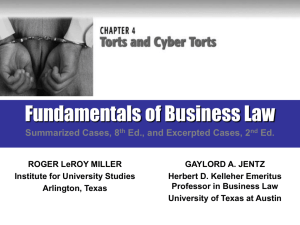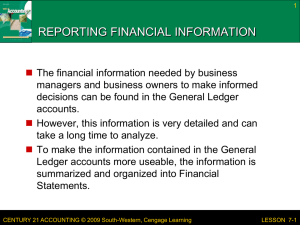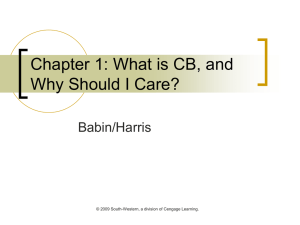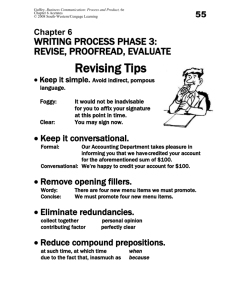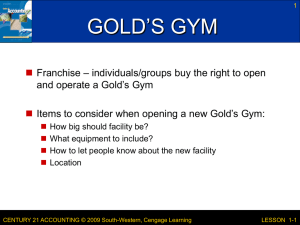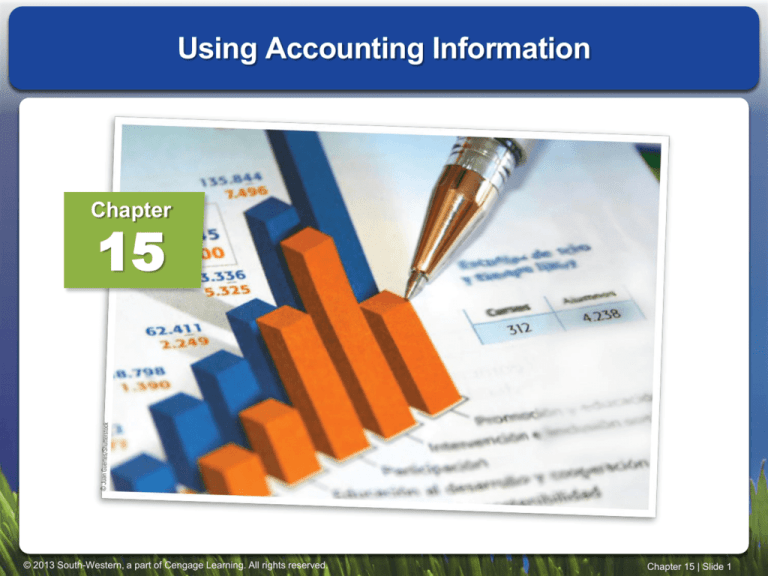
Using Accounting Information
Chapter
15
© 2013 South-Western, a part of Cengage Learning. All rights reserved.
Chapter 15 | Slide 1
Why Accounting Information
Is Important
What is an audit?
• An examination of a company’s financial statements
and accounting practices
• Generally accepted accounting principles (GAAPs)—
an accepted set of guidelines and practices for U.S.
companies reporting financial information and the
accounting profession
The Sarbanes-Oxley Act of 2002
• Top executives must certify periodic financial reports
and are liable for intentional violations of reporting
requirements.
• Auditors must maintain financial documents and audit
work papers for five years.
© 2013 South-Western, a part of Cengage Learning. All rights reserved.
Chapter 15 | Slide 2
Why Accounting Information
Is Important (cont.)
The Sarbanes-Oxley Act of 2002 (cont.)
• Auditors and accountants can be imprisoned for up
to twenty years and subject to fines for destroying
documents and violating securities laws.
• A public corporation must change its lead auditing
firm every five years.
• There is protection for whistle-blowers who report
violations of the Sarbanes-Oxley Act but only for
violations of securities fraud (deception related to
stock values).
© 2013 South-Western, a part of Cengage Learning. All rights reserved.
Chapter 15 | Slide 3
Who Uses Accounting Information
Managers use the information the most!
Lenders, suppliers, stockholders, potential
investors, and government agencies are
other users
© 2013 South-Western, a part of Cengage Learning. All rights reserved.
Chapter 15 | Slide 4
The Accounting Equation
Assets = Liabilities + Owners’ Equity
• Assets—the resources that a business owns
(e.g., cash, inventory, equipment, and real estate)
• Liabilities—the firm’s debts
• Owners’ equity—the difference between assets and
liabilities (what would be left for the owners if the firm’s
assets were sold and the money used to pay off its
liabilities)
Double-entry bookkeeping system: each financial transaction is
recorded as two separate accounting entries to maintain the balance
of the accounting equation. For example, if a business buys a
computer for an employee to use, the column that shows what the
business owns goes up, but the cash column goes down.
© 2013 South-Western, a part of Cengage Learning. All rights reserved.
Chapter 15 | Slide 5
The Accounting Cycle
The accounting cycle
• Done on a regular basis
1. Analyze source documents
2. Record transactions as they occur in the general
journal
3. Post transactions to accounts in the general ledger
Done at the end of the period
• Prepare the trial balance of all general ledger
accounts
• Prepare financial statements and close the books
© 2013 South-Western, a part of Cengage Learning. All rights reserved.
Chapter 15 | Slide 6
The Accounting Cycle
1. Analyze
source
documents
5. Prepare
the
financial
statements
and Close
the Books
4. Prepare
the trial
balance
© 2013 South-Western, a part of Cengage Learning. All rights reserved.
2. Record
transactions
3. Post
transactions
Chapter 15 | Slide 7
The Balance Sheet
A summary of the dollar amounts of a firm’s
assets, liabilities, and owners’ equity accounts
at the end of a specific accounting period
What’s on the Balance Sheet?
• Assets
• Liabilities
• Owners’ Equity
© 2013 South-Western, a part of Cengage Learning. All rights reserved.
Chapter 15 | Slide 8
Assets
Assets-Listed in order of liquidity (ease with which an asset
can be sold for cash)
• Current assets—can quickly be converted into cash or
that will be used in one year or less
–
Cash, marketable securities (stocks), accounts
receivable, notes receivable, inventory, and prepaid
expenses
• Fixed assets—will be held or used for a period longer
than one year
–
–
Land, buildings, and equipment
Depreciation—the process of apportioning the cost of a fixed
asset over the period during which it will be used
• Intangible assets—do not exist physically but have a
value based on the rights or privileges they confer on
the firm, ie, goodwill, patents
–
Patents, copyrights, trademarks, and goodwill
© 2013 South-Western, a part of Cengage Learning. All rights reserved.
Chapter 15 | Slide 9
Balance Sheet Assets Listed
Most Liquid
Least Liquid
© 2013 South-Western, a part of Cengage Learning. All rights reserved.
Chapter 15 | Slide 10
Liabilities
Liabilities
• Current liabilities—debts to be repaid in one year
or less
–
Accounts payable—short-term obligations that arise as a
result of making credit purchases
–
–
Example: Electric bill, purchases from suppliers, etc.
Notes payable—people or other companies who owe you
money
• Long-term liabilities—debts that need not be repaid
for at least one year
–
Mortgages, bonds, and long-term loans
© 2013 South-Western, a part of Cengage Learning. All rights reserved.
Chapter 15 | Slide 11
Owners’ Equity
Owners’ equity
• For sole proprietorships—
Assets – liabilities = owners’ equity
• For partnerships—each partner’s share of ownership
is reported separately in each owner’s name
• For corporations—
–
Equals stockholders’ equity
–
Retained earnings—profits not distributed to
stockholders
© 2013 South-Western, a part of Cengage Learning. All rights reserved.
Chapter 15 | Slide 12
Personal Balance Sheet
© 2013 South-Western, a part of Cengage Learning. All rights reserved.
Chapter 15 | Slide 13
Business Balance Sheetsee pg 450 in book
© 2013 South-Western, a part of Cengage Learning. All rights reserved.
Chapter 15 | Slide 14
The Income Statement
A summary of a firm’s revenues and expenses
during a specified accounting period
• Shows Profit or Loss
Revenues (Sales)
• What are revenues (sales)? The dollar amounts
earned by a firm from selling goods, providing services,
or performing business activities
–
Gross sales (also called total revenues)—the total dollar
amount of all goods and services sold during the accounting
period
–
Net sales—the actual dollar amounts received by a firm for
the goods and services it has sold, after subtracting out
returns, allowances, discounts
• Gross sales and gross profit are not the same thing!
© 2013 South-Western, a part of Cengage Learning. All rights reserved.
Chapter 15 | Slide 15
The Income Statement (cont.)
What is Gross Profit?
Gross profit = Net sales - Cost of Goods Sold
What is Cost of goods sold (COGS)?
Cost of =
goods sold
Beginning +
Net
Ending
–
inventory
purchases
inventory
What does that mean?
• A simple explanation is that COGS tells us how
much it cost us to sell what we sold.
© 2013 South-Western, a part of Cengage Learning. All rights reserved.
Chapter 15 | Slide 16
The Income Statement (cont.)
Operating expenses
• All business costs other than the cost of goods sold
– Selling expenses—costs related to marketing activities
– General expenses—costs of managing the business
The Income Statement will show net income
(if positive) or net loss (if negative)
© 2013 South-Western, a part of Cengage Learning. All rights reserved.
Chapter 15 | Slide 17
Personal Income Statement
© 2013 South-Western, a part of Cengage Learning. All rights reserved.
Chapter 15 | Slide 18
Business Income
Statement-see pg
454.
© 2013 South-Western, a part of Cengage Learning. All rights reserved.
Chapter 15 | Slide 19
Team Exercise
For each of the following accounts, indicate whether it
belongs on a balance sheet or an income statement.
•
•
•
•
•
•
•
•
•
•
Rent
Cash
Patent
Mortgage payment
Net income
Salaries payable
Delivery equipment
Sales
Cost of goods sold
Common stock
© 2013 South-Western, a part of Cengage Learning. All rights reserved.
Chapter 15 | Slide 20
Cash Flow Statement
Illustrates how the operating, investing, and
financing activities of a company affect cash
during an accounting period
• Cash flows from operating activities
(providing goods and services)
• Cash flows from investing activities
(purchase and sale of land, equipment, and other assets
and investments)
• Cash flows from financing activities
(changes in debt obligation and owners’ equity accounts)
© 2013 South-Western, a part of Cengage Learning. All rights reserved.
Chapter 15 | Slide 21
Cash Flow Statementsee pg 456.
© 2013 South-Western, a part of Cengage Learning. All rights reserved.
Chapter 15 | Slide 22
Comparison of Financial Statements
Statement
Timeframe
Income
Up to 1 year
Balance
Sheet
Since the
beginning of the
company
Assets
Liabilities
Equity
Up to 1 year
Operating
Investment
Financing
Cash Flow
© 2013 South-Western, a part of Cengage Learning. All rights reserved.
Main Accounts
Income
Expense
Profit
Chapter 15 | Slide 23
Evaluating Financial Statements
Using accounting information to evaluate
a potential investment
• Use common sense to interpret the numbers.
• Financial statements should be audited by an
•
•
•
•
outside source and be current.
Look for use of new strategies to reduce costs.
Determine the firm’s ability to pay its debts and
borrow money in the future.
Look at how the numbers relate to each other.
Understand the financial ratios.
© 2013 South-Western, a part of Cengage Learning. All rights reserved.
Chapter 15 | Slide 24
Comparing Data with Other Firms’ Data
Comparisons are possible because of GAAP.
Managers can get a general idea of a firm’s relative
effectiveness and its standing within the industry.
Data are available from annual reports of public
corporations.
Industry averages are available from Dun &
Bradstreet, Standard & Poor’s, and industry trade
associations.
© 2013 South-Western, a part of Cengage Learning. All rights reserved.
Chapter 15 | Slide 25
Financial Ratios
Numbers that show the relationship between two
elements of a firm’s financial statements
Can be compared with:
• The firm’s own past ratios
• Ratios of competitors
• Industry averages
Information to calculate ratios is found on a
firm’s balance sheet, income statement, and
statement of cash flows
© 2013 South-Western, a part of Cengage Learning. All rights reserved.
Chapter 15 | Slide 26
Financial Ratios (cont.)
© 2013 South-Western, a part of Cengage Learning. All rights reserved.
Chapter 15 | Slide 27
Using the Internet
There are many online sources for obtaining
company information and annual reports. Here are
just two.
http://www.hoovers.com/free/
http://www.annualreportservice.com/
© 2013 South-Western, a part of Cengage Learning. All rights reserved.
Chapter 15 | Slide 28
Chapter Quiz
1. The __________ is designed to improve
accounting standards.
A.
B.
C.
D.
E.
Ethics in Accounting Act
Graham-Rudman Reform Act
Sarbanes-Oxley Act
Securities and Exchange Accounting Act
Accounting Standards Establishment Act
© 2013 South-Western, a part of Cengage Learning. All rights reserved.
Chapter 15 | Slide 29
Chapter Quiz
2. The first step in the accounting cycle is to
A.
B.
C.
D.
E.
analyze source documents.
record individual transactions.
post individual transactions.
construct a beginning financial statement.
prepare a list of employees.
© 2013 South-Western, a part of Cengage Learning. All rights reserved.
Chapter 15 | Slide 30
Chapter Quiz
3. Assets, liabilities, and owners’ equity would
be listed on a firm’s
A.
B.
C.
D.
E.
balance sheet.
income statement.
statement of earnings.
statement of retained earnings.
statement of capital.
© 2013 South-Western, a part of Cengage Learning. All rights reserved.
Chapter 15 | Slide 31


